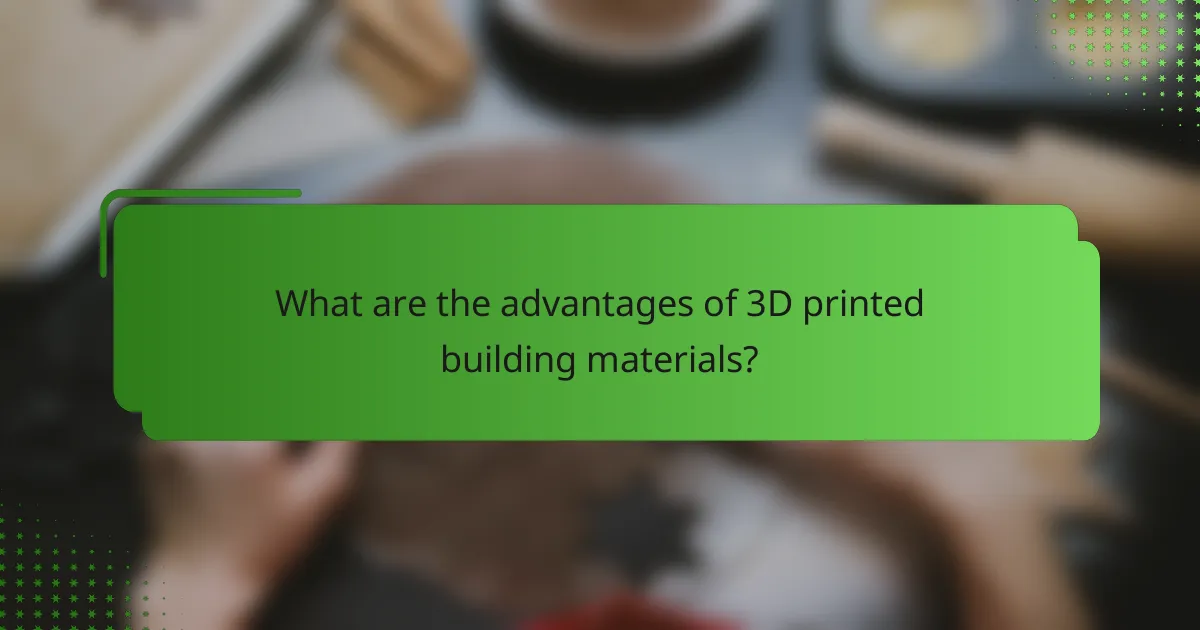3D printed building materials are revolutionizing the construction industry by offering significant advantages such as cost savings, reduced waste, and enhanced design flexibility. Their innovative applications span residential, commercial, and infrastructure projects, making them a versatile choice for modern construction. Additionally, these materials promote sustainability by utilizing eco-friendly resources and improving energy efficiency, ultimately leading to a lower environmental impact.

What are the advantages of 3D printed building materials?
3D printed building materials offer several advantages, including cost savings, reduced waste, and enhanced design flexibility. These benefits make them increasingly popular in the construction industry, promoting sustainability and efficiency.
Cost efficiency
3D printing can significantly lower construction costs by minimizing labor and material expenses. Traditional building methods often require extensive labor and multiple materials, whereas 3D printing can produce components directly from digital models, reducing the need for manual work.
Additionally, the technology allows for the use of less expensive materials, which can lead to overall project savings. For instance, using locally sourced materials can further decrease transportation costs, making projects more economically viable.
Reduced waste
One of the key benefits of 3D printed building materials is their ability to minimize waste. Traditional construction often results in excess materials being discarded, while 3D printing uses only the necessary amount of material to create each component.
This precision not only conserves resources but also lowers disposal costs and environmental impact. By utilizing materials efficiently, projects can align better with sustainability goals and reduce their carbon footprint.
Design flexibility
3D printing allows for a high degree of design flexibility, enabling architects and builders to create complex shapes and structures that would be difficult or impossible with conventional methods. This capability fosters innovation in architectural design, allowing for unique and customized buildings.
Moreover, the ability to easily modify digital designs means that changes can be implemented quickly without significant delays or costs, enhancing the overall adaptability of construction projects.
Faster construction
3D printed building materials can accelerate the construction process, often reducing project timelines significantly. Components can be printed on-site or off-site, allowing for simultaneous construction and assembly, which speeds up the overall workflow.
This rapid production capability can be particularly advantageous in urgent housing situations or disaster recovery efforts, where timely shelter is critical.
Enhanced durability
3D printed materials can offer enhanced durability compared to traditional building materials. The precision of the printing process allows for the creation of structures that are optimized for strength and resilience, often using innovative materials that improve longevity.
Additionally, many 3D printing techniques can incorporate advanced composites or additives that enhance the performance of the final product, making buildings more resistant to environmental factors and wear over time.

What are the applications of 3D printed building materials?
3D printed building materials have diverse applications across various sectors, including residential, commercial, and infrastructure projects. Their ability to create complex shapes and reduce waste makes them an innovative choice for modern construction.
Residential construction
In residential construction, 3D printed materials can be used to create entire homes or specific components like walls and roofs. This technology allows for rapid construction, often reducing build times significantly compared to traditional methods.
For instance, some projects have reported completion times of under 24 hours for a small house. Additionally, the customization options available through 3D printing enable homeowners to design unique spaces tailored to their needs.
Commercial buildings
3D printing is increasingly utilized in commercial building projects, where it can produce intricate facades and structural elements. This method not only enhances design flexibility but also minimizes material waste, which can lead to cost savings.
Examples include office buildings and retail spaces that incorporate 3D printed features, allowing for distinctive architectural styles that stand out in urban environments. Companies can also benefit from faster project timelines, which can improve return on investment.
Infrastructure projects
Infrastructure projects, such as bridges and public facilities, are leveraging 3D printed materials for their durability and efficiency. These materials can withstand harsh environmental conditions while being produced more sustainably than traditional options.
For example, 3D printed concrete can be used in the construction of pedestrian bridges, offering a quicker and more eco-friendly alternative. Local governments are exploring these technologies to enhance public works while adhering to budget constraints.
Art installations
Art installations are another exciting application of 3D printed building materials, allowing artists to create complex sculptures and interactive pieces. The precision of 3D printing enables detailed designs that would be difficult to achieve through conventional methods.
Artists can experiment with various materials and textures, resulting in unique works that engage audiences in new ways. Additionally, 3D printing can reduce the time and cost associated with producing large-scale art pieces, making it accessible to more creators.

How do 3D printed building materials contribute to sustainability?
3D printed building materials enhance sustainability by reducing waste, utilizing eco-friendly resources, and improving energy efficiency. These innovations lead to more sustainable construction practices and lower environmental impact.
Use of eco-friendly materials
3D printing in construction often employs sustainable materials such as recycled plastics, bio-based composites, and natural aggregates. These materials not only minimize the depletion of non-renewable resources but also reduce the overall environmental footprint of building projects.
For example, using materials like hempcrete or mycelium can provide strong structural properties while being biodegradable. This shift towards eco-friendly options supports a circular economy in the construction industry.
Energy efficiency
3D printed buildings can be designed for optimal energy efficiency, utilizing advanced insulation techniques and passive solar design. This results in structures that require less energy for heating and cooling, significantly lowering energy consumption over their lifespan.
Additionally, the precision of 3D printing reduces the energy needed during the construction process, as less material waste translates to lower energy use in manufacturing and transport. This can lead to energy savings of up to 30% compared to traditional building methods.
Lower carbon footprint
The use of 3D printed building materials can significantly lower the carbon footprint associated with construction. By minimizing waste and utilizing local materials, transportation emissions are reduced, contributing to a smaller overall carbon impact.
Moreover, many 3D printing processes are designed to be more efficient, often resulting in lower greenhouse gas emissions compared to conventional construction methods. This approach aligns with global efforts to meet carbon reduction targets and combat climate change.

What are the key considerations for selecting 3D printed building materials?
When selecting 3D printed building materials, key considerations include material properties, regulatory compliance, and the cost versus benefits of the materials. Each factor plays a crucial role in determining the suitability and effectiveness of the materials for specific construction projects.
Material properties
Material properties such as strength, durability, and thermal performance are essential when choosing 3D printed building materials. For instance, concrete-based materials often provide high compressive strength, while polymers may offer flexibility and lighter weight. Understanding these properties helps in selecting materials that meet the structural and environmental demands of a project.
Additionally, consider the material’s resistance to environmental factors like moisture and temperature fluctuations. For example, materials that can withstand extreme weather conditions may be preferable for outdoor applications.
Regulatory compliance
Regulatory compliance is critical when using 3D printed building materials, as construction projects must adhere to local building codes and standards. These regulations often dictate the types of materials that can be used, their performance characteristics, and safety requirements. Familiarize yourself with the relevant codes in your area to ensure compliance.
In some regions, specific certifications may be required for 3D printed materials, such as fire resistance or structural integrity tests. Always verify that the materials you choose meet these standards to avoid potential legal and safety issues.
Cost vs. benefits
Evaluating the cost versus benefits of 3D printed building materials involves analyzing both initial expenses and long-term savings. While 3D printing can reduce labor costs and construction time, the material costs may vary significantly based on the type and quality of the material used. It’s essential to conduct a thorough cost analysis to determine the overall value.
Consider potential savings from reduced waste and energy efficiency as well. For example, materials that allow for precise printing can minimize excess material usage, leading to lower disposal costs. Weigh these factors against the upfront investment to make an informed decision.










